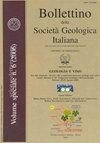Geochemical characterization of an urban lake in the centre of Rome (Lake Bullicante, Italy)
引用次数: 1
Abstract
Urban lakes have become increasingly important in the planning of urban ecology, green infrastructure and green areas in European cities. This paper describes the chemical, isotope and microbial features of Lake Bullicante, a small artificial lake located within the urban area of the city of Rome. It has an anthropogenic origin due to excavation works that intercepted the underlying aquifer, giving rise to a water body. The lake area is 7.000 m2, with a maximum depth of 7 m and located on the distal deposits of the Alban Hills Volcanic District in an area named Acqua Bullicante (i.e. Bubbling Water), where degassing phenomena were historically recorded. The proximity of this volcanic district motivated the study on Lake Bullicante as a potential open-air laboratory to trace possible degassing phenomena in a highly urbanized area. A preliminary geochemical and microbial sampling survey was carried out in winter 2018. Samples were collected along a vertical profile of the lake from the surface to the maximum depth. Major, minor, trace elements, dissolved gases and stable isotopes (δD-H2O, δ18O- H2O, δ13C-CO2) were analyzed, along with the analysis of 87Sr/86Sr ratio. The microbial community characteristics were analysed by epifluorescence microscopy (CARD-FISH) and flow cytometry. The chemical composition and water isotopes suggest that lake water has a meteoric origin and is related to a Ca-HCO3 shallow aquifer hosted in volcanic rocks. This is confirmed by both the 87Sr/86Sr ratio of lake water, which falls in the range of values of Alban Hills volcanites, and the chemical-isotopic composition of neighboring wells. A relatively high concentration of dissolved CO2, its isotopic signature (δ^13C-CO2 20‰ V-PDB), and the high content in organic matter (DOC 10-30 mg/L) suggest for the lake a eutrophication state with denitrification also occurring. Considering the relatively high concentrations of dissolved CO2, an external input of carbon dioxide cannot be completely excluded and as a consequence, not even the hypothesis of mixing processes between biotic and inorganic CO2. This makes further investigations necessary especially during the summer, when the lake is stratified. A summer survey could be also useful to better understand the microbial processes into the lake, its eutrophication evolution and health status, and to plan eventual proper remediation strategies, providing important tools to the local administration and stakeholders to improve, protect and preserve this ecological niche.罗马市中心一个城市湖泊(意大利布利坎特湖)的地球化学特征
城市湖泊在欧洲城市生态、绿色基础设施和绿地规划中发挥着越来越重要的作用。本文描述了位于罗马市区内的一个小型人工湖Bullicante湖的化学、同位素和微生物特征。它有一个人为的起源,因为挖掘工程拦截了下面的含水层,产生了一个水体。湖泊面积为7000平方米,最大深度为7米,位于阿尔班山火山区的远端沉积物上,名为Acqua Bullicante(即冒泡水),历史上记录了脱气现象。靠近这个火山地区促使我们将布利坎特湖作为一个潜在的露天实验室来研究高度城市化地区可能出现的脱气现象。2018年冬季进行了初步的地球化学和微生物采样调查。样本是沿着湖泊的垂直剖面从表面到最大深度收集的。分析了主要元素、微量元素、溶解气体和稳定同位素(δD-H2O、δ18O- H2O、δ13C-CO2),并分析了87Sr/86Sr比值。用CARD-FISH和流式细胞术分析微生物群落特征。湖泊水的化学成分和水同位素表明湖水具有大气成因,并与火山岩中的Ca-HCO3浅层含水层有关。湖水87Sr/86Sr比值落在奥尔班山火山岩的范围内,邻近井的化学同位素组成也证实了这一点。水体中溶解CO2浓度较高,其同位素特征(δ^13C-CO2 20‰V-PDB),有机质含量(DOC 10 ~ 30 mg/L)较高,表明湖泊处于富营养化状态,同时存在反硝化作用。考虑到溶解二氧化碳的浓度相对较高,不能完全排除二氧化碳的外部输入,因此,甚至不能排除生物和无机二氧化碳混合过程的假设。这使得进一步的调查成为必要,特别是在夏季,当湖泊分层时。夏季调查也有助于更好地了解微生物进入湖泊的过程,其富营养化演变和健康状况,并规划最终适当的补救策略,为地方政府和利益相关者提供重要的工具,以改善、保护和保存这一生态位。
本文章由计算机程序翻译,如有差异,请以英文原文为准。
求助全文
约1分钟内获得全文
求助全文

 求助内容:
求助内容: 应助结果提醒方式:
应助结果提醒方式:


